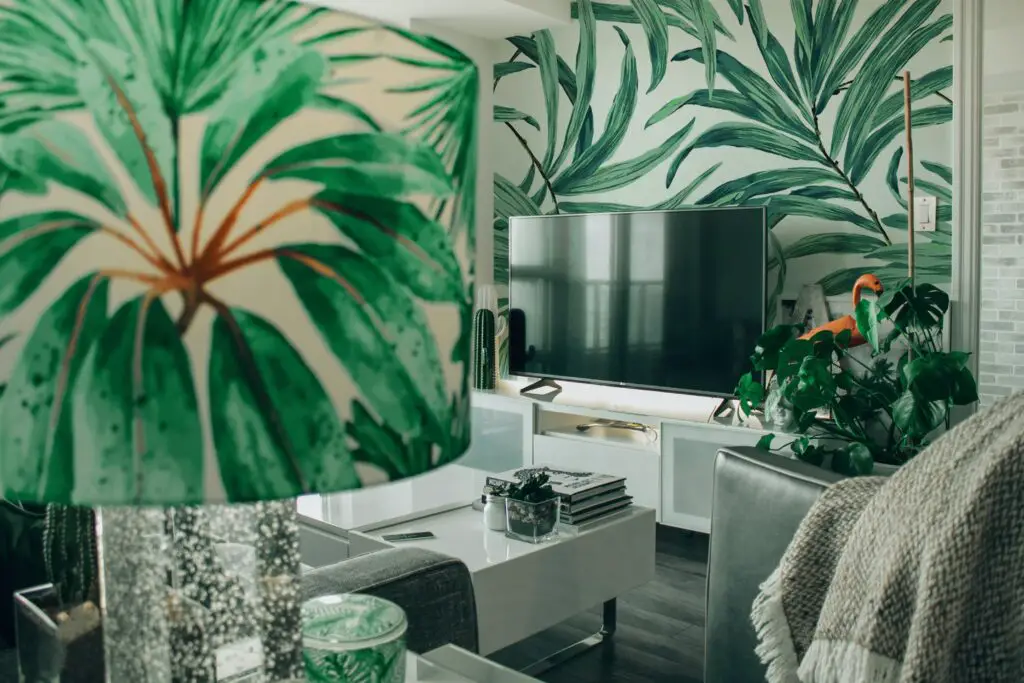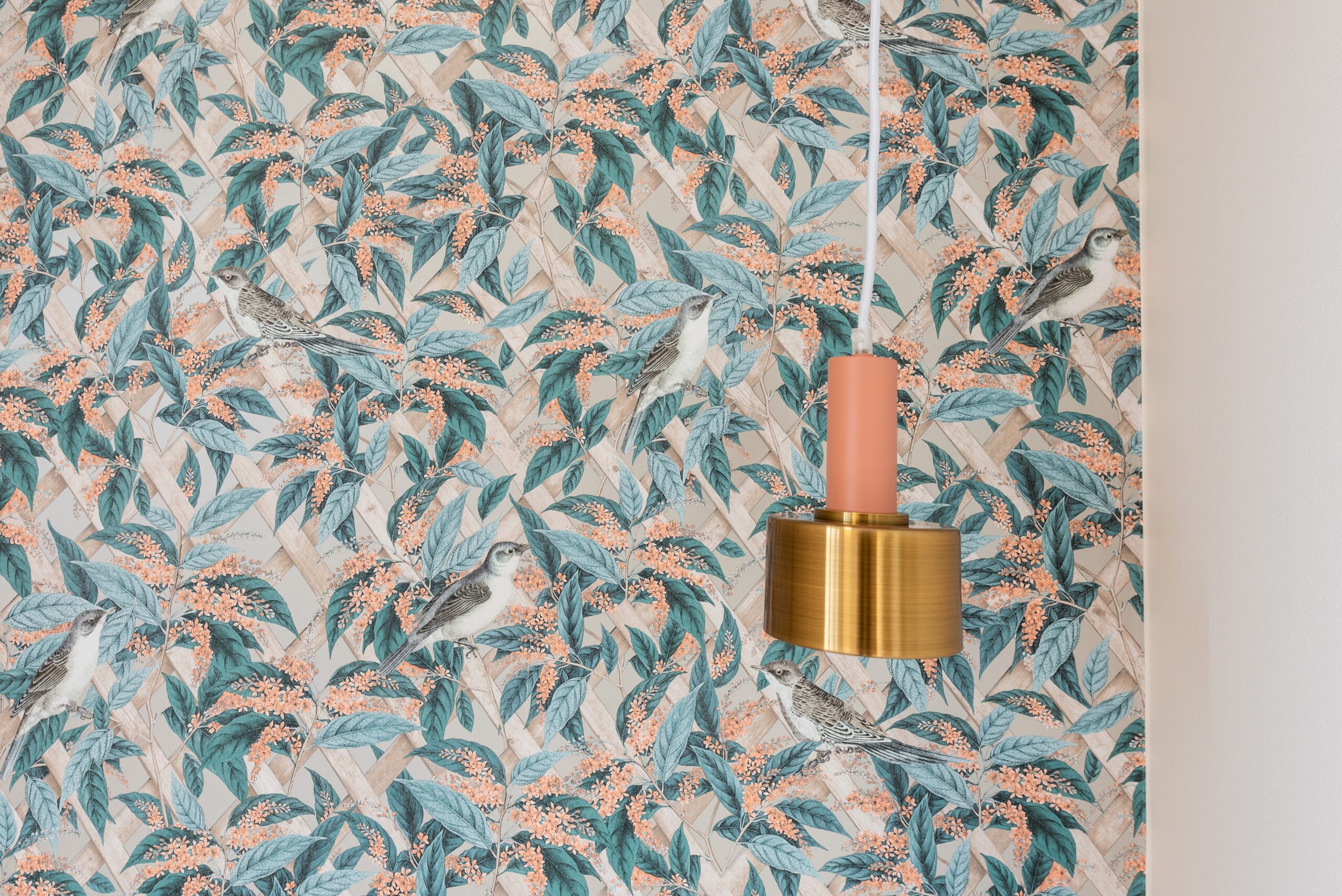Are you looking to give your living spaces a fresh new look? Wallpaper is a versatile and creative tool that can completely transform a room. Gone are the days of bland and predictable wallpaper designs. Nowadays, countless options are available, ranging from traditional patterns to textured and removable wallpapers.
In this blog post, we will explore creative ways to use wallpaper in room makeovers. So let’s dive in and discover the endless possibilities of using wallpaper as a design element!
I. Choosing the Right Wallpaper

When selecting wallpaper for your room makeover, it’s essential to consider various factors. The type of wallpaper, the room’s style and purpose, color psychology, and durability are all important considerations.
To begin with, there are different types of wallpaper to choose from. Traditional wallpapers offer timeless patterns and designs, while removable wallpapers provide flexibility for those who like to change their decor frequently. Textured wallpapers add depth and interest to a room, while patterned wallpapers can make a bold statement.
Consider the style and purpose of the room before selecting wallpaper. For instance, if you want to create a calming and serene atmosphere in your bedroom, opt for soft, neutral colors. In a vibrant and energetic space like a home office or playroom, you can experiment with vibrant colors and bold patterns.
Color psychology plays a crucial role in setting the mood of a room. Warm colors like reds and oranges evoke energy and excitement, while cool colors like blues and greens promote relaxation. Choose wallpaper colors that align with the desired ambiance of the space.
Durability and maintenance requirements are also important factors to consider. In high-traffic areas like hallways or kitchens, opt for durable and washable wallpapers that can withstand daily wear and tear.
II. Focal Points and Accent Walls

Creating a focal point or an accent wall is an excellent way to add visual interest and create a statement in a room. Wallpaper can be a powerful tool for achieving this effect.
When selecting a wall for a focal point, consider architectural features or prominent areas in the room. It could be the wall behind a bed, a fireplace, or a large empty wall that needs attention. By applying wallpaper to this wall, you can instantly draw the eye and create a captivating centerpiece.
When choosing wallpaper for an accent wall, consider bold and eye-catching patterns or textures that contrast with the surrounding walls. This will ensure that the accent wall stands out and becomes the focal point of the room. Make sure to coordinate the wallpaper with the existing furniture and accessories to create a cohesive and harmonious look.
To further enhance the accent wall, consider incorporating additional elements such as strategic lighting or artwork. Proper lighting can highlight the texture and patterns of the wallpaper, while carefully selected artwork can complement the overall design.
III. Creating Illusions and Optical Effects

Wallpaper can be a powerful tool to create illusions and optical effects, making a room appear larger, taller, or more dimensional.
If you have a small space that feels cramped, you can use wallpaper to visually enlarge it. Opt for wallpaper with light colors and subtle patterns to give the illusion of a larger area. Additionally, vertical stripes can make the ceilings appear higher, creating a sense of spaciousness.
Adding depth and texture to a room is another way to use wallpaper creatively. Textured wallpapers, such as those with embossed designs or 3D effects, can add a tactile element to the walls and create visual interest. These wallpapers work particularly well in rooms that lack architectural features or have plain walls.
Trompe l’oeil, a technique that uses realistic imagery to create optical illusions, can also be achieved with wallpaper. By choosing wallpapers that mimic architectural elements like brick walls, wooden panels, or bookshelves, you can create the illusion of texture and depth without needing expensive renovations.
IV. Unique Applications of Wallpaper

While walls are the most common area for applying wallpaper, there are many unconventional spaces where wallpaper can add a unique touch to your room makeovers.
Consider applying wallpaper to the ceiling for a surprising and dramatic effect. This can add a sense of depth and visual interest to a room. Choose wallpapers with patterns or designs that complement the overall decor of the space.
Doors, cabinets, and built-in shelves can also benefit from a wallpaper makeover. By applying wallpaper to these surfaces, you can instantly transform them into focal points. For example, a vibrant floral wallpaper on a cabinet door can bring life to a neutral kitchen or bathroom.
Another creative application of wallpaper is using it as a decorative backdrop for shelving units or bookcases. By lining the back of the shelves with wallpaper, you can add a pop of color or pattern to showcase your books, collectibles, or decor items.
Stair risers are often overlooked when it comes to room makeovers. However, they offer a perfect opportunity to infuse some personality into your space. By applying wallpaper to the stair risers, you can create a vibrant and unexpected look that will impress anyone who walks up the stairs.
V. Mixing and Matching Patterns

When using wallpaper creatively, don’t be afraid to mix and match patterns. Pattern mixing can add depth and visual interest to a room, creating a unique and eclectic aesthetic.
The key to successful pattern mixing is understanding the principles of coordination and balance. Start by selecting a primary pattern that will serve as the focal point. It could be a large-scale floral design, a bold geometric pattern, or an abstract motif.
Once you have your primary pattern, choose secondary patterns that complement it. These can be smaller-scale patterns or textures that add depth without overpowering the primary pattern. Consider using complementary colors or similar tones to create a cohesive look.
To balance busy patterns, incorporate solid colors or neutral elements into the design. This will provide a visual relief and prevent the patterns from overwhelming the space. For example, if you have a bold pattern on the walls, balance it with solid-colored furniture or curtains.
VI. Incorporating Wallpaper in Unconventional Spaces

Wallpaper is not limited to living rooms or bedrooms. It can also be used creatively in unconventional spaces to make a statement and set the tone for the entire home.
Bathrooms and kitchens are often overlooked when it comes to wallpaper, but they can greatly benefit from its use. In the bathroom, choose moisture-resistant wallpapers that can withstand the humid environment. Consider floral patterns for a romantic and whimsical touch or geometric designs for a modern and sleek look. Opt for wipeable wallpapers in the kitchen that can handle splashes and stains. Look for patterns that complement the cabinets and countertops for a cohesive design.
Closets and cabinets are often hidden away, but they can become delightful surprises when adorned with wallpaper. Apply wallpaper to the inside of closets or cabinets to create a burst of color or pattern every time you open them. This unexpected detail can bring joy and personality to your everyday routine.
If you have a home office or workspace, consider incorporating wallpaper on the back of a desk or an entire wall. This can create an inspiring and visually appealing backdrop for your work. Choose wallpaper designs that reflect your style and motivate your creativity.
Hallways and foyers are the entry points to your home and set the first impression for guests. Use wallpaper to make a statement and create a welcoming atmosphere. Whether you opt for bold patterns or subtle textures, the wallpaper in these spaces can set the tone for the entire home.
VII. DIY Wallpaper Crafts and Projects

Don’t let wallpaper remnants go to waste! There are plenty of DIY projects that can utilize these smaller pieces and transform them into unique and personalized decor items.
One idea is repurposing wallpaper remnants for smaller projects such as picture frames, coasters, or decorative boxes. By applying wallpaper to these items, you can create one-of-a-kind pieces that match your room’s aesthetic.
If you have larger pieces of wallpaper or leftover rolls, consider creating custom wallpaper art pieces or canvases. Cut the wallpaper into different shapes or patterns and arrange them on a blank canvas or frame. This can be a cost-effective way to create personalized artwork that reflects your style.
Wallpaper can also be used to design unique lampshades or pendant lights. By applying wallpaper to the lampshade frame or the exterior of a pendant light, you can add a pop of color or pattern to your lighting fixtures. This simple DIY project can instantly elevate the look of your room.
Another creative DIY project is a decoupage with wallpaper. Apply wallpaper to furniture or home decor items using decoupage techniques for a custom look. This can be a great way to revamp old or outdated pieces and give them new life.
VIII. Care and Maintenance of Wallpaper

To ensure the longevity and beauty of your wallpaper, proper care and maintenance are essential. Here are some tips to help you keep your wallpaper in top condition:
- Installation and Removal: Follow the manufacturer’s instructions for properly installing and removing wallpaper. Improper techniques can damage the wallpaper or the walls.
- Cleaning: Regularly dust your wallpaper using a soft brush or a microfiber cloth. Use a mild soap and water solution to remove any stains or marks for washable wallpapers. Test the cleaning solution on a small, inconspicuous area before applying it to the entire wallpaper.
- Addressing Issues: If you notice any peeling or loose edges, use a small amount of wallpaper adhesive to secure them back. For minor scratches or scuffs, use a colored pencil or a marker that matches the wallpaper to camouflage the imperfections.
- Protection: Consider applying a protective layer such as varnish or laminate to high-traffic areas or areas prone to moisture, like kitchens or bathrooms. This can help protect the wallpaper from damage and make cleaning easier.
By following these care and maintenance tips, you can ensure that your wallpaper stays vibrant and beautiful for years.
Conclusion
Wallpaper is a versatile and creative tool that can completely transform your living spaces. From accent walls to unconventional applications, the possibilities are endless.
Remember to choose the right wallpaper for your space, considering factors like type, style, color psychology, and durability. Get creative with patterns, mix and match; don’t be afraid to experiment. Let your imagination guide you, whether you’re revamping a bedroom, adding personality to a hallway, or repurposing wallpaper for DIY projects.
FAQs (Frequently Asked Questions)
1. Can you use wallpaper in high-moisture areas like bathrooms and kitchens?
Absolutely! There are moisture-resistant wallpapers available specifically designed for such areas. Look for wallpapers labeled as washable and durable to withstand the humidity and occasional splashes.
2. How do you mix and match patterns with wallpaper?
Mixing and matching patterns can be a fun way to create an eclectic and personalized look. Start with a primary pattern that you love and build around it. Choose secondary patterns that complement the primary ones, considering factors like scale, color palette, and style. Incorporate solid colors or neutral elements to balance out busy patterns and create a harmonious overall design.
3. How do you care for and clean wallpaper?
Regular maintenance and cleaning can keep your wallpaper looking fresh and vibrant. Dust the wallpaper regularly with a soft brush or microfiber cloth. Use a mild soap and water solution to remove stains or marks for washable wallpapers. Test the cleaning solution on a small, inconspicuous area before applying it to the entire wallpaper. If you notice any peeling edges, use wallpaper adhesive to secure them back. Consider applying a protective layer like varnish or laminate to high-traffic areas for added durability.



